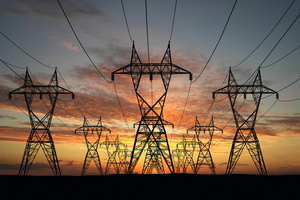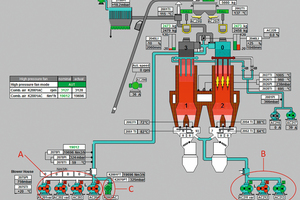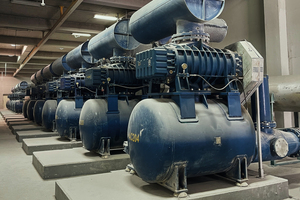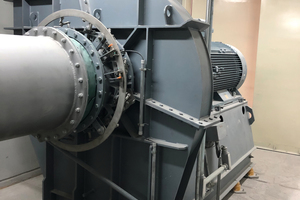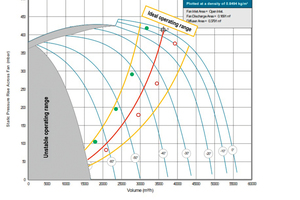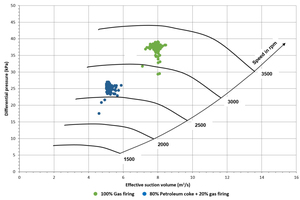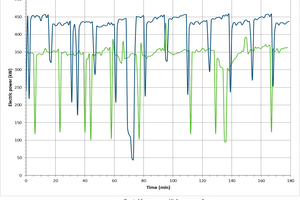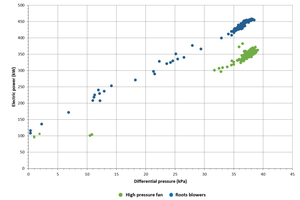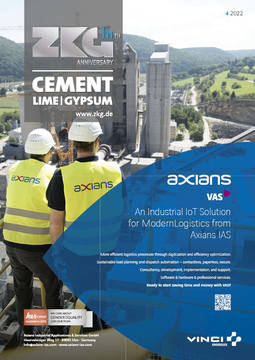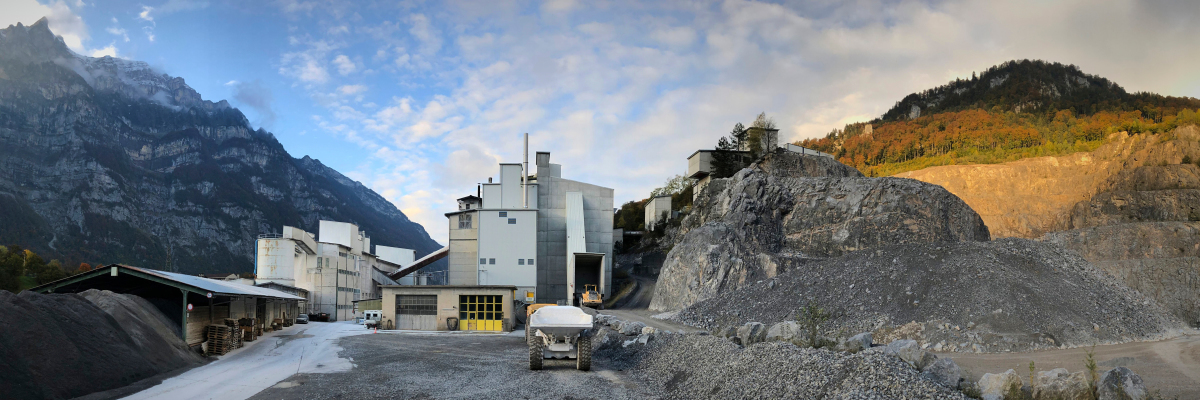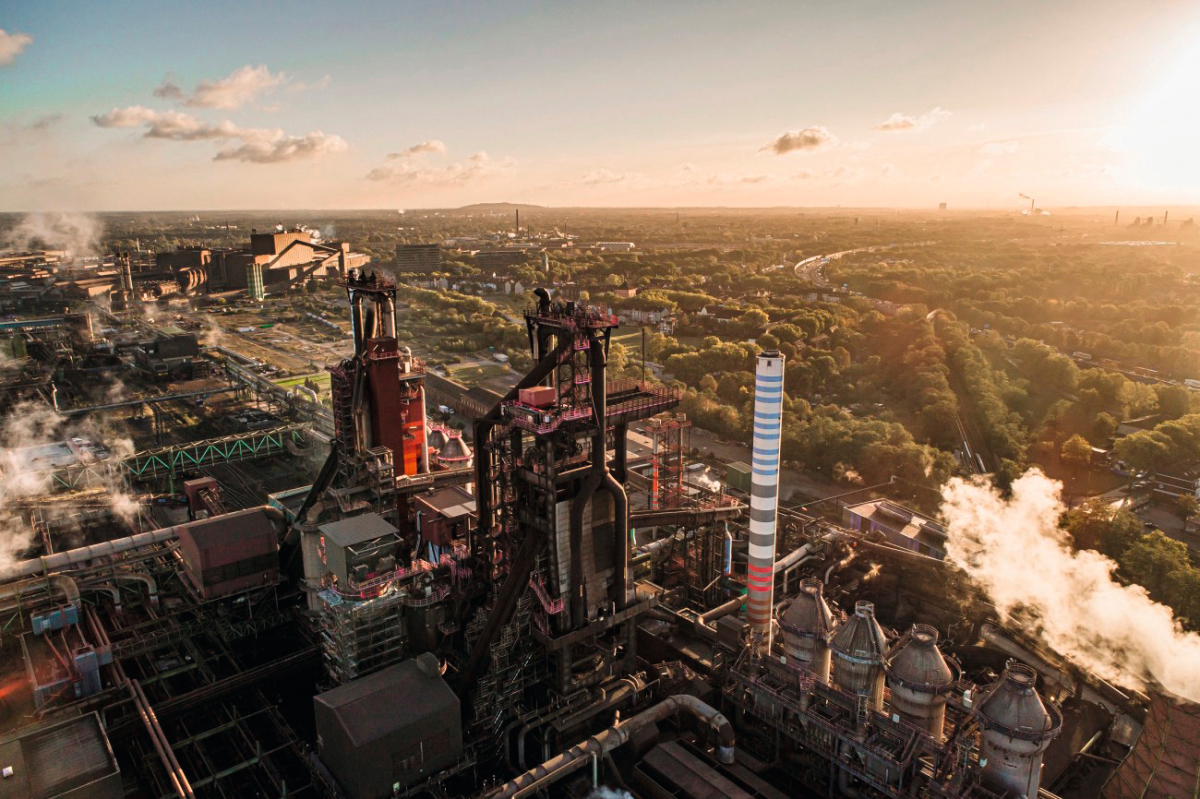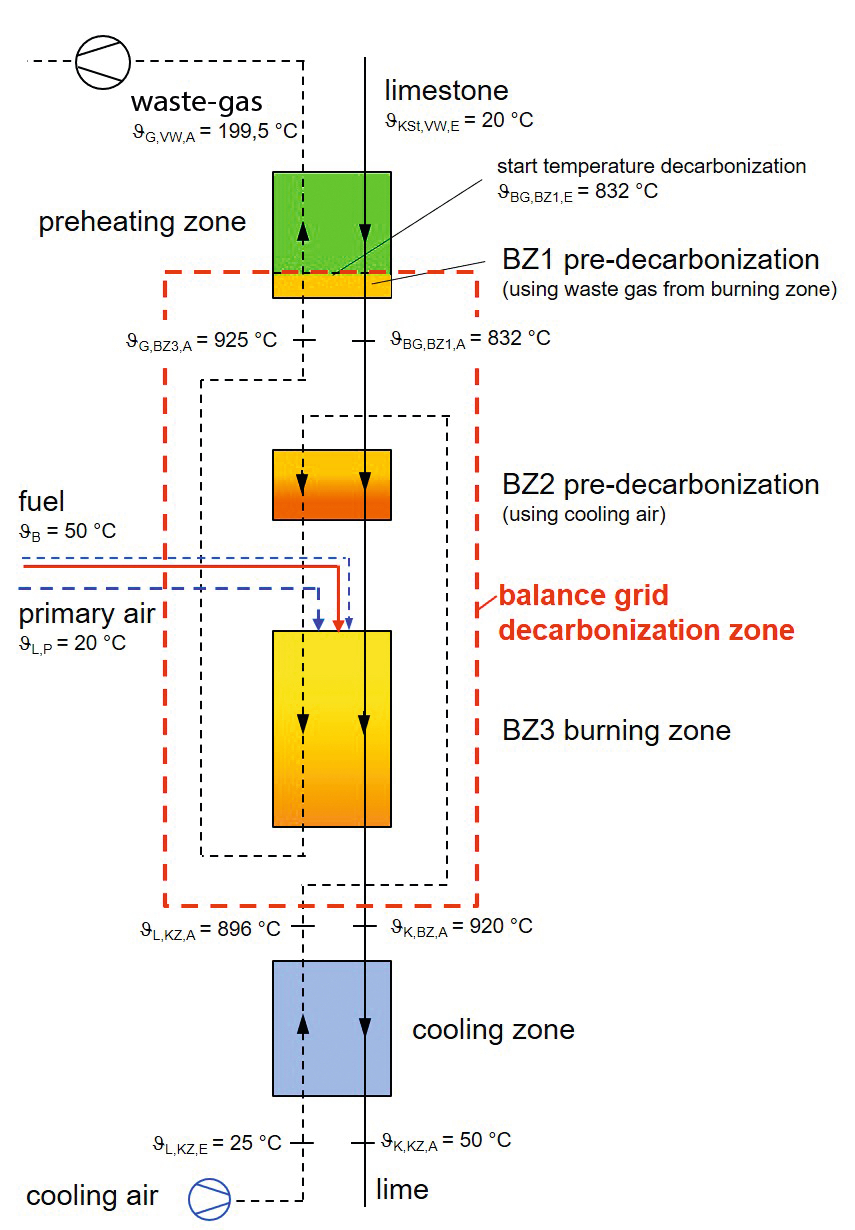How to save 20% electric energy in Maerz PFR lime kilns
Maerz Ofenbau AG and Grupo Calidra successfully installed and commissioned a high-pressure radial fan on a Maerz PFR lime kiln, thereby saving 20% of electric energy consumption compared to roots blowers (rotary piston blowers).
Introduction
Maerz Ofenbau AG’s parallel flow regenerative (PFR) lime kilns produce high reactive lime with the best thermal efficiency of all lime kiln types. A further reduction in thermal energy consumption is almost impossible. However, the electric power consumption for the combustion and cooling air supply can still be improved. As previously announced in Global Cement Magazine [1], Maerz Ofenbau AG has developed a new PFR kiln process (patent pending) using high-pressure radial fans instead of roots blowers to provide the necessary air for the calcination process and lime cooling.
High-pressure radial fans have an efficiency of 80 to 86%, surpassing the previously used roots blowers with an efficiency of only 60 to 65%. Together with Grupo Calidra, Maerz Ofenbau AG successfully installed and operated the first high-pressure radial fan for combustion air in one of Calidra’s Maerz PFR lime kilns in Mexico. When firing the kiln with natural gas, the electric power consumption was reduced by 20%. When firing the kiln with 80% petroleum coke and 20% natural gas, the reduction was still 18%.
Maerz PFR lime kilns
A Maerz PFR kiln has two shafts connected by a crossover channel permitting a gas flow between the shafts (Figure 1). One of these is the burning shaft and the other the regenerative shaft, changing its function cyclically approx. every 15 min. The stone continuously moves top down through both of them. As the kiln operates at overpressure, air is compressed and conveyed into the top of the burning shaft, flowing down and reacting with the injected fuel. The hot combustion gas flows – together with the CO2 deriving from the process and 50% of the lime cooling air – through the cross-over channel to the regenerative shaft and is mixed there with the rest of the cooling air. It is then discharged at the top of the regenerative shaft. The limestone in the regenerative shaft is thereby pre-heated before being calcined in the next cycle. In the lower part of the shafts the lime is cooled with air in counterflow.
Besides the energy provided by the fuel for combustion, a PFR kiln typically consumes 30–50 kWh electric power per ton of lime. Most of this energy is required to compress the air. A typical air supply system for a PFR kiln comprises 4-5 roots blowers (Figure 1 A) for combustion air and 3-4 roots blowers for cooling air (Figure 1 B). Roots blowers, however, only have an efficiency of about 60%. To reduce the electric power consumption, high-pressure radial fans with an efficiency of 80% can be used. In a first step at Calidra, only one single high-pressure radial fan (Figure 1 C) replaced all roots blowers for combustion air. In a possible next step, another high-pressure radial fan could replace all cooling air blowers.
Advantages of high-pressure radial fans
Additionally, to their superiority in terms of efficiency, high-pressure radial fans have several other advantages. Compressing air causes high noise emissions and therefore both the roots blowers and the high-pressure radial fans must be placed inside a blower house to reduce the noise levels. The sheer number of roots blowers leads to a large and expensive building and comparatively complicated ductwork (Figure 2). Only two high-pressure radial fans (Figure 3) can replace all these roots blowers. Reducing the number of machines also reduces the investment costs, not only for the machines but also for the building, the ductwork and the electric installation. This makes high-pressure radial fans economically even more attractive.
In older lime kilns, only one of the four combustion air blowers is usually equipped with a variable drive, whereas the others run at a fixed speed. This leads to gaps in coverage of the operating range, which has to be considered by the kiln operator. High-pressure radial fans do not face this issue. Their wide flexibility in terms of operating pressure and volume flow rate allows for covering a much broader, seamless operating range. The “old truth” that a PFR kiln can only be operated with fans that have a flow rate proportional to the speed is now obsolete. A flow measurement in the intake duct of the high-pressure radial fan and a PI-controller take care of the correct amount of air supplied to the kiln.
Theoretical and real behaviour of high-pressure radial fans
A high-pressure radial fan is characterised by its typical performance curve (Figure 4). Of particular interest are the “optimal operating range” (yellow), where the efficiency is the highest and the “unstable operating range” (grey), where aerodynamic stall at the rotor blades can cause vibrations. To maintain an almost constant efficiency, the system’s pressure resistance curve should conform to the square law, which is almost the case with PFR kilns. The performance curves of the installed high-pressure radial fan were determined by measurements on site (Figure 5). Although there is no clear peak or strong descent at low volume flow, the curves are quite similar to the theoretical ones. For further tests, the kiln was set to its maximum production capacity of 440 t/d. One test was performed with pure natural gas firing and the other one with 80% petroleum coke and 20% natural gas. Much more combustion air was used with gas firing because an excess air factor of 1.19 was required. In contrast to this, a much smaller amount of air was required for operation with 80% petroleum coke and 20% gas, since an excess air factor of only 0.85 had to be set. The comparison of the measured results with the theoretical curves shows that the operating parameters for gas firing are at the centre of the ideal operating range, whereas the parameters for mixed firing are closer to the edge.
There are a few things to consider when operating a high-pressure radial fan. Periodically increasing loads can reduce the fatigue strength of the impeller and shorten its service life due to large increases in the fan’s rotation speed. PFR kilns operate cyclically with typically 90 to 120 burning cycles per day. Between the burning cycles no combustion air can be conveyed into the kiln, however, as mentioned before, the high-pressure radial fan should maintain a constant rotation speed. A simple modification of the operating procedure solved this issue.
Another challenge was that, at constant rotation speed, a high-pressure radial fan supplies much more air when the pressure decreases. This leads to an increased power consumption, which is contradictory to its purpose, namely the reduction of electric power consumption. With an inlet vane regulator and dampers in the fan pressure line together with another simple modification of the operating procedure, this issue was also solved and the electric power consumption during the kiln reversal was drastically reduced (Figure 6) keeping the rotation speed of the impeller relatively constant over the entire timeline.
Comparison of power consumption between high-pressure radial fans and roots blowers
The electric power consumption was measured during two consecutive operating periods. First, the kiln was operated with the high-pressure radial fan using 100% natural gas firing. Afterwards the operation was switched back to the four roots blowers. The performance of the high-pressure radial fan was very stable through several cycles (Figure 6) and the power consumption was significantly lower compared to the operation with roots blowers. The difference measured during these tests was 19.8%.
In a second step the same tests were repeated using a mixture of 80% petroleum coke and 20% natural gas firing. Due to the smaller volume flow, the conditions during this trial were less favourable for a high-pressure radial fan and thus the saving in electric power consumption was only 17.9%.
Another challenge with this installation was the high compression ratio caused by the plant’s location at an altitude of 2450 m above sea level. However, the successful operation has shown that a differential pressure of up to 450 mbar can be generated with a single-stage centrifugal fan.
The power consumption of both the high-pressure radial fan and the roots blowers depends on the counter pressure in the kiln, which may fluctuate due to the movement of the material bed. Therefore, in order to compare multiple cycles, the power consumption was plotted against the actual pressure (Figure 7). This comparison again confirms the advantage of high-pressure radial fans over conventional roots blowers by about 20% savings in electric power consumption.
Outlook and next steps
Grupo Calidra, a global player in lime production, operates 33 PFR kilns and has two new PFR kilns under construction in the Americas. Almost all existing PFR kilns are equipped with roots blowers and only a few of them with hybrid blowers (screw type). Therefore, there is great potential for the use of high-pressure radial fans on the existing kilns in order to save operational costs and CO2 emissions caused by electric power generation. The operation experience with hybrid blowers over several years has shown that there was almost no energy saving compared to roots blowers. Theoretically, the efficiency of hybrid blowers should be at approximately 70%, but the investment costs of such machines are significantly higher than roots blowers or high-pressure radial fans.
Grupo Calidra plans to use high-pressure radial fans instead of roots and hybrid blowers on their new PFR kilns, which are currently under construction. These new kilns will be installed below 700 m and not at 2450 m above sea level. For this reason, the efficiency of the high-pressure radial fans will be as high as 86% and the expected savings compared to roots blowers could be up to 25%. Regarding the existing PFR kilns, Grupo Calidra will evaluate which of these kilns could be converted to high-pressure radial fans. For example, it would certainly make sense not to replace old roots blowers with new ones, but rather replace them with high-pressure radial fans.
For tomorrow’s rising costs for emitting CO2 and the path towards lower emissions in the lime industry, further technological improvements need to be implemented. As already published in this journal last year [2], Maerz Ofenbau AG has developed a new series of lime kilns to avoid CO2 emissions to the atmosphere by providing the kilns’ exhaust gases ready for further use in downstream processes (CCU) or sequestration (CCS). The new Maerz EcoKiln® series (patents pending) enriches the CO2 in the exhaust gases up to between 90 and 97%. This makes CCU/CCS systems economically feasible and emitting large amounts of CO2 to the atmosphere is no longer an environmental drawback for the lime industry. This process, however, makes it necessary to re-circulate part of the exhaust gas back to the kiln. Since high-pressure radial fans can handle gases at temperatures of up to 150 °C, the use of such fans is the first choice for this new technology.
Summary
Grupo Calidra and Maerz Ofenbau AG replaced four roots blowers, which provide combustion air to one of Calidra’s PFR kilns in Mexico, with one single high-pressure radial fan. Several tests with the kiln operating on different kind of fuels proved the high-pressure radial fan’s reliable operation. The comparison between the electric power consumption of the existing roots blowers and the new high-pressure radial fan shows a saving in electric energy of about 20%. For Grupo Calidra, this is an excellent opportunity to save energy, CO2 emissions caused by electric power generation as well as operating costs. For Maerz Ofenbau AG it means not only being able to better serve its customers with a new technology to upgrade existing kilns, but it is also a milestone in the development of the new Maerz EcoKiln® series.

